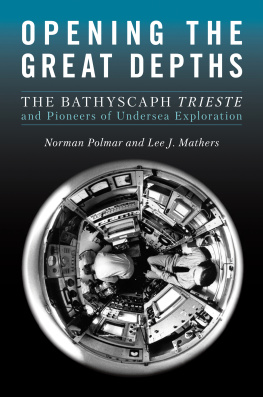Norman C. Polmar - Opening the Great Depths: The Bathyscaph Trieste and Pioneers of Undersea Exploration
Here you can read online Norman C. Polmar - Opening the Great Depths: The Bathyscaph Trieste and Pioneers of Undersea Exploration full text of the book (entire story) in english for free. Download pdf and epub, get meaning, cover and reviews about this ebook. City: Annapolis, year: 2021, publisher: Naval Institute Press, genre: History. Description of the work, (preface) as well as reviews are available. Best literature library LitArk.com created for fans of good reading and offers a wide selection of genres:
Romance novel
Science fiction
Adventure
Detective
Science
History
Home and family
Prose
Art
Politics
Computer
Non-fiction
Religion
Business
Children
Humor
Choose a favorite category and find really read worthwhile books. Enjoy immersion in the world of imagination, feel the emotions of the characters or learn something new for yourself, make an fascinating discovery.
- Book:Opening the Great Depths: The Bathyscaph Trieste and Pioneers of Undersea Exploration
- Author:
- Publisher:Naval Institute Press
- Genre:
- Year:2021
- City:Annapolis
- Rating:3 / 5
- Favourites:Add to favourites
- Your mark:
Opening the Great Depths: The Bathyscaph Trieste and Pioneers of Undersea Exploration: summary, description and annotation
We offer to read an annotation, description, summary or preface (depends on what the author of the book "Opening the Great Depths: The Bathyscaph Trieste and Pioneers of Undersea Exploration" wrote himself). If you haven't found the necessary information about the book — write in the comments, we will try to find it.
Developed by French physicist Auguste Piccard and his son Jacques, the bathyscaph Trieste was a scientific marvel that allowed unprecedented scientific, technical, and military feats in the ocean depths. France and the United States both acquired and subsequently developed variants of the original bathyscaph. While both France and the United States employed the bathyscaph as a tool for scientific investigation of the deepest ocean depths, the U.S. Navy developed and employed the Trieste for military missions as well. From its earliest years, participants in the Trieste program realized that they were making history, blazing a trail into previously unexplored and unexploited depths, developing new capabilities and opening a new frontier. Comparisons with developments in space and the space-race between the United States and the Soviet Union often were made concerning the Trieste program and contemporary developments in undersea technologies and capabilities.
The Trieste opened the entire oceans to exploration, exploitation, and operations. The bathyscaph was a first-generation system, a Model-T that spawned an entirely new industry and encouraged new concepts for deep-ocean naval operations. Advances in deep-sea technologies lacked the gee-whiz factor of the concurrent space race, but were highly significant in the development of new technology, new knowledge, and new military capabilities.
Opening the Great Depths is the story of the three Trieste deep-ocean vehicles, their officers and enlisted men, and the civilians, often told in their own words, documenting for the first time the earliest years of humanitys probing into Earths final frontier.
Norman C. Polmar: author's other books
Who wrote Opening the Great Depths: The Bathyscaph Trieste and Pioneers of Undersea Exploration? Find out the surname, the name of the author of the book and a list of all author's works by series.












 Print editions meet the requirements of ANSI/NISO z39.48-1992 (Permanence of Paper).
Print editions meet the requirements of ANSI/NISO z39.48-1992 (Permanence of Paper).